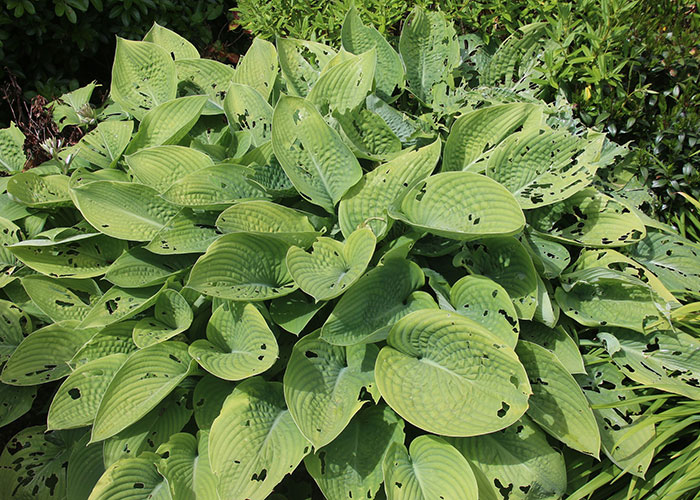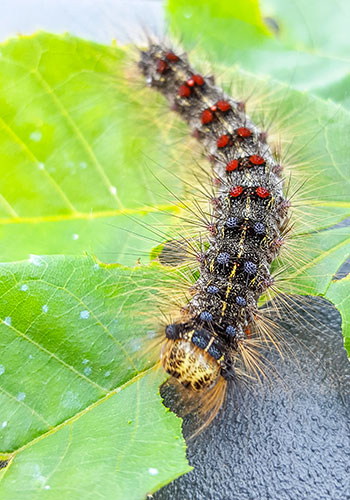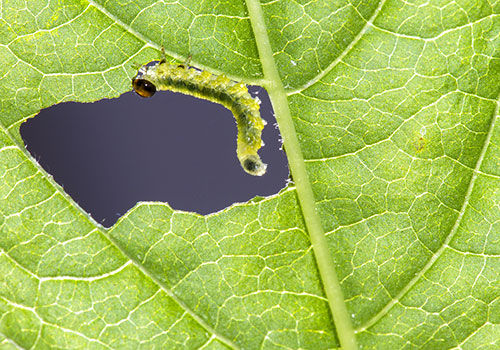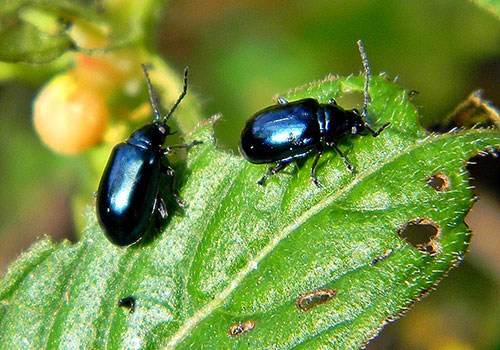Pest Damage ID Part 1: Who’s chewing holes in my leaves?
If you garden long enough, sooner or later some pest is going to break your heart. Maybe your freshly emerged seedlings will be mowed down to the ground, your favorite flowers will emerge twisted and discolored, or you’ll find an entire shrub defoliated in a matter of days. There are many wonderful and rewarding things about gardening, but these disappointments are not among them.
Pests may be one of the most frustrating facts of gardening, but knowing who you’re dealing with can go a long way towards mitigating problems or even preventing them before they start. Understanding more about how different pests affect your plants can also help you recognize when you have a real problem on your hands and when it might be okay to relax. The good news is that the list of usual suspects is actually not all that long.
Let’s start with some of the most common and noticeable pests: the ones that chew holes in your leaves. In future posts, we’ll cover pests that suck juices out of leaves or tunnel through them, as well as mammal and bird pests.
Slugs & Snails
Slugs and snails use their sandpaper-like mouthparts to wear away at tender foliage. If you see rounded, smooth holes that are often in the center of your leaves rather than the edges, there’s a very good chance that you’re dealing with slugs and snails. You may or may not see their tell-tale slime trails. Since they are nocturnal, you probably won’t see many of the culprits themselves during normal gardening hours.
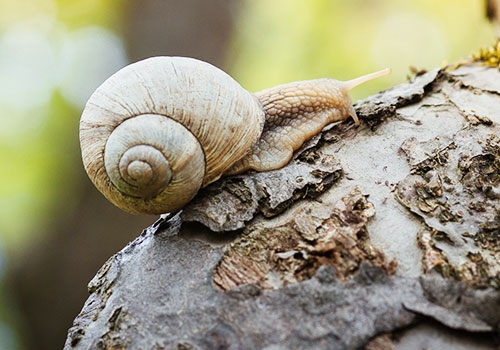 There’s probably no need to worry if you’re only seeing a few holes here and there. Slugs and snails are a part of every garden, and completely eradicating them would be both unrealistic and ecologically unwise. But if large parts of entire leaves are disappearing overnight or multiple newly emerged seedlings are being mowed to the ground, the population may be out of balance.
There’s probably no need to worry if you’re only seeing a few holes here and there. Slugs and snails are a part of every garden, and completely eradicating them would be both unrealistic and ecologically unwise. But if large parts of entire leaves are disappearing overnight or multiple newly emerged seedlings are being mowed to the ground, the population may be out of balance.
We’ve already done a deep dive into natural slug and snail management, so we’ll just cover the basics here.
Slugs and snails are mollusks, which makes them more closely related to clams and squid than they are to any of their fellow garden creatures. Sluggo® and other natural slug baits are targeted towards mollusks specifically, so they may have less impact on other creatures than other pesticides. However, they are still not 100% safe for all of our garden friends.
There are many non-pesticide methods for managing slugs out there, and they’re all detailed in the blog post linked above. Unfortunately, we find that the most labor-intensive also tends to be the most effective: Head out there early in the morning, late in the evening, or even at night with a headlamp, and pluck those critters off of your plants yourself!
Photo: Gypsy Moth - WA Dept. of Agriculture (click for link)
Caterpillars
Second only to slugs and snails in the “chewing holes in your leaves” category are caterpillars: the larvae of moths and butterflies. As with slugs and snails, you are likely to notice the damage before you see the culprits. Many of the most destructive caterpillars are small, green, and very good at blending in with plant leaves.
Unlike slug and snail damage, holes chewed by caterpillars tend to be jagged or “bite mark” shaped rather than smooth, and you probably won’t see those partially worn-through “windows” often left by the rasping mouthparts of mollusks. You may also see their “frass” (which is just a polite word for insect poop), which will look like small brown or green pellets.
The first thing to keep in mind if you suspect caterpillars is that most species are the larvae of native moths and butterflies. Wildlife-friendly gardeners would like to keep these around. Unless they are wildly overpopulated for some reason, these native pollinator larvae also don’t tend to cause enough damage to be of real concern. Monitor your plants. If you’re just seeing a few holes here and there, you can congratulate yourself on attracting native pollinators and sit back. But if the damage is severe, you may have a real issue on your hands.
The two kinds of caterpillars that typically become a real concern in the Pacific Northwest are western tent caterpillars and cabbage worms.
Tent caterpillars are the larvae of a native moth. Although they are a natural part of the ecosystem, their unique habit of gathering in large colonies covered in webbing creates an eyesore and can potentially cause significant harm to young trees and shrubs. The good news is that their social lifestyle also makes them fairly easy to control when they are found early on smaller plants. When you see a colony beginning to form early in the spring, simply prune off the affected branch and dunk it in soapy water. Many songbirds also love to feast on tent caterpillars, so attracting birds to your garden is a great natural control.
Cabbage worms are velvety-looking green caterpillars that can actually be the larvae of several different species. But European cabbage whites are among the most common and most damaging. You’ve almost certainly seen the adult butterflies in your garden: they are white with a small black dot on each wing. They typically affect vegetables, especially those in the cabbage family, but they can eat other plants as well.
Some of the best controls for cabbage worms include putting a sheet or row cover over their favorite host plants early in the season to prevent eggs from being laid, or looking for and squishing the singly-laid, oblong eggs on the undersides of host plant leaves. (Make sure not to squish oblong eggs found in clusters: they are likely ladybug eggs!) Their natural predators include songbirds, yellow jackets, other wasps, and hornets.
If you find yourself with a real problem infestation on your hands, Bt (Bacillus thuringiensis) can be an effective treatment. Bt is a naturally occurring soil bacteria that makes caterpillars stop eating when they ingest it, so that they eventually starve. It is most effective when caterpillars are young, so catching infestations early is your best bet with it. It only affects larvae of butterflies and moths, but keep in mind that it will affect all butterflies and moth larvae that eat it, so it’s still best to use it only as a last resort.
Sawfly Larvae
But before you reach for the Bt, make sure you’re really dealing with a caterpillar! Sawfly larvae look very similar to caterpillars, and the damage they cause can look very similar as well. But while caterpillars are the larvae of moths and butterflies, sawfly larvae will become fly-like wasps when they grow up.
The difference you are likely to notice first is that sawfly larvae feed in groups whereas caterpillars prefer to dine alone. This can make them much easier to spot, but it also means they can quickly defoliate their plant of choice. If you get close enough, you can also count the stubby little appendages called prolegs on your culprit’s abdomen. Sawflies have at least six pairs, whereas caterpillars have five or fewer.
Sawflies usually eat the foliage of trees and shrubs, and particular species specialize on particular plant families. So a little bit of good news is that they tend to stay relatively contained. As with tent caterpillars, you may be able to remove the whole colony by pruning off a branch.
If the damage is widespread and you need to bring in a spray, spinosad is an option that is allowable in organic gardens. Although it is derived from chemicals produced naturally by soil bacteria, it is still a potent and wide-ranging pesticide that will affect any insect that eats or touches it, including beneficial insects. We recommend only turning to it if you are at risk of losing your plants and there is no other viable option.
Photo: Wikimedia Commons - Bob Peterson (click for link)
Flea Beetles
Flea beetle damage is distinctive: it looks like someone might have fired a shot-gun at your plants. If you see a proliferation of tiny, irregular holes all over your leaves, these tiny beetles are to blame. They can be hard to see because they are usually less than an eighth of an inch long, but if you ruffle your plants’ leaves, you might see them jump.
Vegetable gardeners are the ones who need to be the most concerned about these pests, and between them various species attack most kinds of crops.
The good news is that flea beetles don’t typically pose much threat to mature plants, and quite a few spray-free methods are effective against them. Covering young seedlings with a light cloth or row cover can physically prevent flea beetles from showing up on the scene. By the time you uncover your plants so that pollinators can get to them, they’ll be strong enough to outgrow almost any flea beetle damage. Flea beetles prefer hard, compacted soil, so keeping the soil in your bed loose and full of fluffy compost will deter these pests while also boosting our plants' health.
Organic pesticides like spinosad can work on flea beetles, but again, just because they are allowed in organic gardening doesn’t mean they are “safe.” Just like any pesticide, they should be applied only when absolutely necessary and in as limited an application as possible.
Knowledge is Power
Knowing which pest they’re dealing with can help a gardener a little more in control of their situation. As you take the next step and decide what to do about your pests, keep the big picture in mind. Not every pest needs to be managed, and sometimes management can look more like playing a long game of overall ecosystem management. Remember: always choose the least toxic viable option for a flourishing and sustainable garden. And keep in mind that plants have their own defense systems as well. If you provide your plants with the right conditions and care, you may just find that they are able to fend off many pests on their own.

